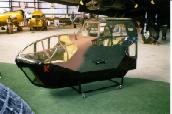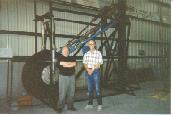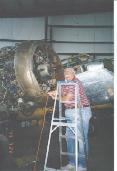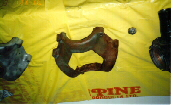 Museum
Museum  |
Bomber Command
|
Aircrew Chronicles
|
Aircrew Losses
|
Nose Art
|
BCATP
|
Lancaster
|
Media
|
Bomber Command
|
Aircrew Chronicles
|
Aircrew Losses
|
Nose Art
|
BCATP
|
Lancaster
|
Media
 Museum
Museum  |
Bomber Command
|
Aircrew Chronicles
|
Aircrew Losses
|
Nose Art
|
BCATP
|
Lancaster
|
Media
|
Bomber Command
|
Aircrew Chronicles
|
Aircrew Losses
|
Nose Art
|
BCATP
|
Lancaster
|
Media
Bomber Command Museum Archived Newsletters
|
September 4, 1999. witnessed another memorable event at the museum where the sacrifice made by an individual during the Second World War was commemorated. Sgt. (Pilot) Albert Stanley Prince was the first Canadian serviceman to be killed during the war and the first of some ten thousand Canadian aircrew to die serving with Bomber Command. He lost his life on the first Bomber Command attack of the war when his Blenheim Bomber was shot down during an attack on enemy warships at Wilhelmshaven. The Society had spent some time researching the raid in which Sgt. Prince participated and locating information regarding this young Canadian pilot. The complete story was summarized by the Society and published in the Summer 1999 issue of Airforce Magazine. It is now available on this website. The ceremonies were held inside the museum which was filled to capacity. Following a welcome by Society President Dan Fox and the introduction of special guests, Dave Birrell described the events of September 4, 1939, during which Sgt. Prince‚s aircraft was lost. Guest speaker Major General Lloyd Campbell from Winnipeg, Manitoba, officer commanding No. 1 Canadian Air Division, described how the traditions, spirit, and dedication of today‚s aircrew had their origins in the operations carried out by Sgt. Prince and his contemporaries in Bomber Command. Derek Farthing, from Dutton, Ontario, the president of the Bomber Command Association of Canada, spoke of the need to educate future generations as to the sacrifices made by Sgt. Prince and the other Ten Thousand Bomber Command Casualties. |
 The Blenheim cockpit section was unveiled on Sept4, 1999, at the special event honouring "The First of the Ten Thousand." |
|
The working example of Lancaster undercarriage was placed on display at the museum in June. Conceived and built by Society Director Larry Wright and member Bill Howe of A-1 Fluid Power in Calgary, the display involves an actual Lancaster undercarriage system including a Lanc wheel and tire. All of the parts were collected by the Society from farms in southern Alberta where wartime Lancasters had been scrapped during the 1950s. The deposit of a dollar begins the demonstration which allows the visitor to observe the retraction of the gear and then its lowering and locking into place for landing. The system was designed to operate at the same speed as in the aircraft. Funds raised through the display are directed to the Lancaster restoration. |
 Bill Howe and Al Wittich. |
|
To the visitor's eye it may appear that little progress has been made in restoring our Blenheim. In spite of appearances this, our "Millennium"
project, is well underway. Much has actually been accomplished over the past few months. The Blenheim's horizontal stabilizer and elevators are nearly ready for application of the fabric. In addition an estimated 90% of all metal repairs to the fuselage have been completed. Work consisted of re-riveting damaged sheet metal seams, patching the wing centre-section, replacing wing root fairings, and repairing the gun turret mounting position. One of our volunteers, AME Greg Morrison, from High River, AB, a former SAIT student employed by the Society about four years ago, has taken on repairing the outboard wing sections. He has one wing well along and should have it finished by year's end. Greg has worked a number of Saturdays and nearly every Tuesday evening (this is 'work night' at the museum) over the summer. He has been assisted several times by Colin Markle and Monica Dauenhauer, who are also AMEs from High River and Calgary respectively. Another volunteer, Charlie Cobb, from Calgary, has been coming nearly every Tuesday night during the summer to work on the Mercury engines. One engine is now ready for a paint upgrade. It is our hope to have most of the work on the aircraft completed by May of 2000. The Society has applied for a federal government "Millennium" grant to do some of the restoration work and have the finished aircraft custom painted. This is an ambitious project. Anyone reading this who would like to help make this happen, please contact us! |
 Charlie Cobb working on one of the Blenheim's Mercury engines. |

